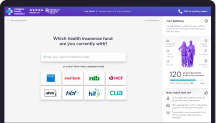Health insurance premiums rise every year in Australia
The 2023 average premium percentage rate increase was 2.9%.
Make sure you’re getting the most value from your current health fund and research new policies regularly.
Health Insurance Premiums Are Rising in Australia. Find Out Why & How The Increase Will Impact You
Are you concerned about the rising health insurance premiums in Australia? You're not alone. Many Australians find themselves wondering why their hard-earned money keeps going towards higher premiums, and they start questioning the actual benefits of their health cover. To help you navigate this situation and make informed decisions, we've created this comprehensive guide. Discover what factors contribute to the increase in health insurance premiums and explore your options, whether you're considering switching policies or even opting out of private health insurance altogether. Our comparison tool allows you to compare a range of options from over 15 not-for-profit health funds in just a few minutes.What is the 2023 Health Insurance Premium Rate Rise?
Health insurance premiums typically increase from the 1st of April each year. Some health funds increase their premiums more than others. The 2023 average premium percentage rate increase announced by the Federal Health Minister was 2.9%. If the 2023 insurance premium rise has left you contemplating whether you can continue to afford private health insurance, understanding your options may help you find a better value policy. By comparing funds, you may find a more affordable health cover that still meets your needs. Or, why not skip ahead and get started with an online quote right now?How Does the 2023 Health Insurance Premium Increase Compare to Previous Years?
Private health insurance premiums have steadily increased over the last 10 years. The below table shows the annual average increase over the last decade. It’s worth noting that this year’s 2.9 percent increase is well below the 10-year average of 4.4 percent.Year
(%)
2013
5.6
2014
6.2
2015
6.18
2016
5.59
2017
54.84
2018
3.95
2019
3.25
2020
2.92
2021
2.74
2022
5.56%
2023
2.7
Total
2.9
Industry Average Premiums: How Does Your Policy Compare?
Interested to know how your health fund premium increase compares with the rest of the insurers? The Department of Health lists the average of premium increases by insurer by year for the last ten years. It’s important to note, these percentages are an average and the premium for your individual policy may be above or below the fund’s average.Why Do Private Health Insurance Premiums Increase?
Have you ever wondered why private health insurance premiums keep rising? It's essential to understand the reasons behind these increases so that you can make informed decisions about your coverage, which we’ll cover below.Covering the Costs and Variations of Insurance Services
One of the primary reasons for the increase in health insurance premiums is to cover the rising costs and variations of insurance services and claims. As medical treatments and technology advance, the expenses associated with providing quality healthcare also increase. To ensure that your health insurance policy can adequately cover these costs, adjustments are made to the premiums.Influence of Rising Medical Costs
The costs of medical treatments and services have been on the rise, and this directly impacts the premiums you pay. Factors such as inflation, increased doctors' fees, wages for hospital staff, and theatre costs all contribute to the overall increase in healthcare expenses. To maintain the financial viability of health insurance providers and continue offering comprehensive coverage, they must adjust premiums accordingly.Maintaining Financial Viability for Sustained Coverage
Health funds strive to maintain reserves to handle unexpected increases in benefit costs. However, if these costs continue to rise persistently, relying solely on reserves becomes unsustainable. In order to remain financially viable and ensure ongoing coverage for members, health insurance providers must increase their income. One way to achieve this is by raising member premiums.How Much Do Premiums Rise By Each Year?
The exact health insurance increase will vary from fund to fund. The rate will also depend on the type of private health insurance policy you hold. The lowest average premium increase in 2023 will be 1.69%. The highest average rate rise for 2023 will be 5.38%. If your premium increases, your health fund provider will notify you in writing. You’ll receive an update to your policy along with any other additional information about the recent change. In the event your premium rate increase was higher than the 2023 average, your health fund has to demonstrate that the increase is necessary to cover the benefits of your policy.What Does the Health Insurance Premium Rate Rise Mean For You?
The 2023 health insurance premium increase will no doubt hit the pocket of many Australians. That’s why it’s important to make sure you’re getting the most value from your current health fund and research new policies regularly. The amount your policy premiums changed in 2023 will depend on your insurer and the type of cover. The Health Minister Media Release dated 6 February 2023 highlights the following premium average price increase:How are health insurance premiums calculated?
Health insurance premiums are based on the Private Health Insurance Community Rating System. This system ensures that “everyone pays the same premium for their health insurance and health funds are prevented from discriminating against members based on health status, age or claims history.” This is not the case with other forms of cover, such as car insurance or life insurance.Can I avoid paying the health insurance rate rise?
Depending on your health fund, you may be able to choose to pay your annual premium in advance before the rate rises. This gives you the opportunity to lock in your premium at the previous year’s premium rate. This could potentially result in savings as you won’t be required to pay the higher premium until the policy expires. It is important to note that not every fund will increase its premiums annually. Some policy premiums could actually decrease and others may remain the same. The best way to avoid paying expensive premiums is to find a great value health insurance policy. Compare your current policy against new policies to make sure you’re getting the most value from your provider at a price you’re happy to pay. If not, it might be time to switch!How can I lock in my premium?
Some private health insurance members choose to ‘lock in’ their premiums before the rate rise comes into effect in April. This means you lock in your premium at the current rate, delaying having to pay any increase for up to 12 months. To be eligible to do so and pay a lower premium, you need to process your annual premium payment before 1st April. It’s worth remembering, processing funds by the bank can take up to 6 days. Leaving it too late could see you miss the deadline to lock in your premiums.Where Does the Premium Money I Pay Go?
Well, the answer largely depends on your health insurer, but let's shed some light on the matter. The majority of the premiums you pay end up indirectly benefiting you and your fellow members through various benefits tied to hospital and extras cover. It's a way for the insurer to ensure that when you need medical care, you're well taken care of. Additionally, a portion of the premiums goes towards compensating hospitals, doctors, and medical practitioners for their services. Now, here's where it gets interesting. The amount that insurers retain as profits or allocate towards operational costs varies from one insurer to another. Some insurers, like us, operate as not-for-profit organisations. That means any profits we retain are reinvested back into improving services and enhancing member benefits. It's our way of prioritising your well-being above all else. While it's true that rising premiums are influenced by the increasing costs in the healthcare industry, it's also important to note that Australians are now claiming more health insurance benefits than ever before. As a result, insurers must adjust their premiums to accommodate these rising claims and ensure they can continue to provide comprehensive coverage to their members.* Industry average updated 19 December 2019
If you have any questions or queries with your health cover or premiums, we have friendly staff who are all health insurance experts. You can call one of our team on 1300 806 119
FAQs
1. What is Lifetime Health Cover (LHC) loading, and how does it affect my health insurance premiums?Lifetime Health Cover loading is a government initiative in Australia that encourages people to take out private health insurance earlier in life and maintain it. If you don't have hospital cover by the age of 31, and you decide to take it out later, you may have to pay an additional loading on top of your premium. The loading increases by 2% for every year you're aged over 30 when you take out hospital cover, up to a maximum of 70%. This loading can significantly increase your health insurance premiums.
2. What’s the difference between being a private patient and a public patient in a hospital?
Being a private patient in a hospital means that you have private health insurance, and you choose to be treated in a private hospital or as a private patient in a public hospital. As a private patient, you may have the choice of doctor, shorter waiting times, and more control over your treatment. Public patients, on the other hand, are treated in public hospitals and are typically covered by Medicare. The hospital determines the order of treatment based on medical needs, and you may not have the same level of choice or amenities as a private patient.
3. What are annual limits in health insurance, and how do they impact my coverage?
Annual limits refer to the maximum amount of money you can claim on a specific service or treatment within a calendar year. Health insurance policies often have different annual limits for various services such as dental, physiotherapy, or optical services. Once you reach the annual limit for a particular service, you will need to pay for any further treatments or services out of pocket. It's important to understand your policy's annual limits to manage your health expenses effectively.
4. How does the Health Insurance Act influence the regulations and policies of health insurance providers?
The Health Insurance Act is a legislation in Australia that governs the private health insurance industry. It sets out the rules and regulations that health insurance providers must follow, including standards for coverage, pricing, waiting periods, and the provision of information to policyholders. The Act aims to protect consumers and ensure that health insurance providers operate fairly and transparently.
5. I'm a single parent. Are there any specific health insurance options or considerations that apply to me and my family?
As a single parent, you have specific health insurance options and considerations to keep in mind. Some health insurance providers offer family policies that cover both you and your children. These policies can include hospital cover for maternity services, paediatric care, and extras cover for services like dental, physio and optical care. It's important to compare different health insurance plans and consider your family's healthcare needs to choose a policy that provides appropriate coverage and meets your budget. Additionally, you may be eligible for the Australian Government Rebate on private health insurance, which can help reduce the cost of premiums.





